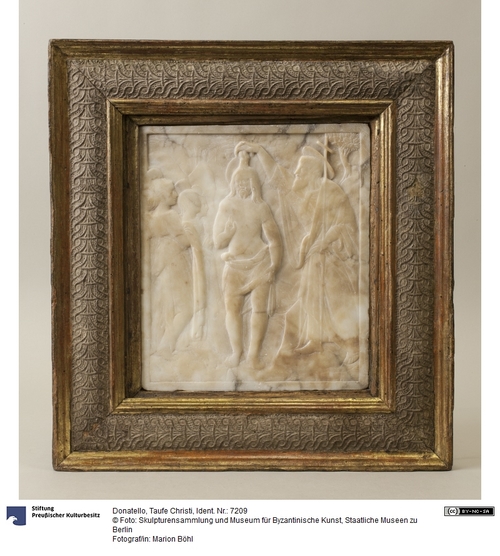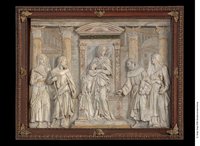Attributed to Donatello and workshop
The Baptism of Christ
Marble
33.5 x 29.5 cm (with frame)
29.9 x 25.5 cm (without)
Berlin, Staatliche Museen, Skulpturensammlung, Inv. 7209.
Bode-Museum, storage.
Provenance
Berlin, Adolf von Beckerath (until 1916); Berlin, Skulpturensammlung/Kaiser-Friedrich-Museum (1916-1939); Berlin, storage (1939-1945); Merkers, storage (1945); Wiesbaden, Central Collecting Point (1945-1956); West Berlin, Skulpturensammlung/Museum Dahlem (1956-1990); Berlin, Skulpturensammlung/Museum Dahlem (1990-1997); Berlin, storage (1997-2006); Berlin, Skulpturensammlung/Bode-Museum (since 2006).
Acquisition
Bought in 1916, sale Adolf von Beckerath, lot 40. Anonymous gift.
Comment
This relief represents the Baptism of Christ, with Jesus at the centre, blessing, John the Baptist to his his left, pouring holy water on Christ’s head, and three angels holding Christ’s mantle on the other side. Even though the surface of the relief is largely abraded, especially in the body of Christ and the Baptist, a close view reveals many details imperceptible from a distance: the profiles of the angels are extremely fine, as are the left angel’s wings overlapping the sculpted frame; around the head of Christ, one can see at close range the heads of no fewer than six cherubs, silently blessing the sacred event; the landscape is filled with trees, the sky with clouds. Having never been reproduced in detail, hung high up on a wall in the Kaiser-Friedrich-Museum and mostly in storage since the war, this work has always been neglected in the art historical literature, but it is surely a masterpiece of the Sculpture Collection of the Berlin Museums.
When he first published the work, just after its acquisition, Bode 1916 thought of a Florentine artist at the middle of the 15h century. Even though he later gave the relief to Donatello himself (Bode 1926), Schottmüller 1933 preferred to list it in her catalogue of the Berlin Sculpture Collection as by his workshop. The affinities with the master’s works, as for instance the Assumption of Christ and the Gift of the Keys in the Victoria and Albert Museum, London, were counterbalanced by a too weak execution according to Schottmüller 1933, who drew an interesting parallel with another Baptism of Christ, made in 1429 for the Baptismal Font of the Cathedral in Arezzo. This comparison was repeated by Avery 1994, who tentatively ascribed both works to Donatello (while he had omitted the Berlin one in the catalogue of the master, Charles Avery, Donatello. Catalogo completo delle opere, Florence, Cantini, 1991). As the Baptism in Arezzo is usually given to the master and his workshop (Giancarlo Gentilini, “Ardue ‘vie del marmo’ e ‘figure di pietra’ in terra d’Arezzo”, in Liletta Fornasari, Giancarlo Gentilini and Alessandra Giannotti eds., Arte in terra d’Arezzo. Il Quattrocento, Florence, Edifir, 2008, pp. 186-188), the Berlin version has always been forgotten in this reevaluation.
The case for a direct attribution to Donatello is, however, more than tempting. If the eroded state of the relief gives the impression that the figures of Christ and the Baptist are rather weak, what remains of the anatomy of Christ and the draperies of the Baptist are typical of Donatello (see respectively the Flagellation once in Berlin, Inv. 1979; and the bronze doors of the Old Sacristy in San Lorenzo, Florence). As for the angels on the left, Avery 1994 made a pertinent comparison with the Dudley Madonna in the Victoria and Albert Museum that he gave to Desiderio da Settignano; as shown by Francesco Caglioti, this work is by Donatello and is indeed the more compelling comparison with our relief, as the faces of the angels on the left recall that of the Child in the London relief (see Inv. SKS 2627 for a discussion about the latter). The attribution to Donatello of the relief, or at least the artist’s participation in its execution, should then be taken very
Entstehungsort stilistisch: Florenz
de

